Boon or bane?
While we don’t tire enumerating the advantages of social media, parents’ apprehensions about psychological and neurophysiological impacts on children also merit consideration

I have a 9-year-old who spends half the day at school and the rest of the time on social media. I understand as a modern parent that in today’s day it is impossible to live without social media, but I worry about my child’s mental health and safety. What can I do as a parent?
Is your child glued to social media all day long? Before anything else, you are not alone. Millions of parents are out there questioning themselves, parenting experts and even social media giants that how is social media impacting their young ones.
To begin with, a high percentage of children and teenagers use social media regularly. As per a 2020 report from Common Sense Media that studied the effect of social media and technology on young people, 95 per cent of teens in the US have access to a smartphone and about 45 per cent of them are almost constantly online.
Closer home, a recent study by the National Commission for the Protection of Child Rights showed that 37.8 per cent of children aged 10 have a Facebook account while 24.3 per cent have an Instagram account. The most popular social media platforms currently are Instagram, TikTok (not in India), Snapchat and then Facebook.
Why worry? It’s only social media
Last week, tech giants like Facebook, YouTube, and TikTok were sued by Seattle schools for allegedly contributing to the mental health crisis among youth. The alleged suit is voicing that social media is exploiting the psychology and neurophysiology of these kids with the motive to maximise profit at the expense of the mental health of young audiences, leading to stress, isolation, and anxiety.
Social media also promotes validation-seeking behaviours, with excessive selfies and videos uploaded. The first-ever study on selfie addiction (Dutta et al) from India showed higher trends of narcissism and body image dissatisfaction among teenagers.
Last year, in a landmark ruling, a UK court blamed tech companies for the suicide of a 14-year-old girl named Molly Russel. This was considered “The big tobacco moment for social media giants”
What is the dark side of social media and the Internet for kids?
* Excessive use can lead to feelings of anxiety, depression, and loneliness;
* Unrealistic expectations around beauty standards and life;
* Comparison and FOMO;
* Hate speech, trolling and cyberbullying;
* Exposure to nudity;
* Cybercrime;
* Tracking and identity theft;
* Distraction;
* Sleep issues;
* Poor face-to-face interactive skills;
* Poor online privacy;
* Harmful content exposure;
* Catfishing: meeting people who pretend to be someone else;
* Grooming: Pedophiles can exploit children;
* Physical health: Sitting for long hours, text neck syndrome, texter’s thumb, headache, eye strain, poor posture.
Is addiction a possibility?
Yes. Behavioural addiction,
specifically IAD (Internet addiction disorder) has been prevalent
for a while. Social media dependence is widely seen in people belonging to various age groups but is not a diagnosable condition at the moment.
Just like there are two sides of a coin, there can also be a great deal of positives that social media can hand out to kids. Social media can help with:
* Self-expression;
* Finding like-minded community;
* Making connections;
* Tools for learning and research;
* Information about the current occurrences around the world.
How to navigate social media hazards for your young ones? Is your child safe on the Internet?
Honestly, no one is safe online. Not even you. Crimes can occur anywhere, even on social media. What is worse is that most people don’t face any repercussions for the same.
The most common crimes against children on social media are:
* Nudity, pornography, identity theft, grooming, lack of privacy, cyberbullying, scams, sextortion, and online stalking, to name a few.
Safe guidelines recommended are:
* Be a good role model as a parent: Practice everything you preach;
* Teach critical thinking: Parents can handhold and dictate only so much. It is best to teach balance to children from the beginning;
* Stranger danger: Just as in real life, basic rules like “Don’t talk to strangers, don’t take candy from a stranger, and don’t tell a stranger where you live” should be the moral guiding approach for even online behaviour;
* Learn and teach privacy settings on social media platforms;
* Refrain from using live location settings as much;
* Do not share pictures with strangers (new friends included);
* At no cost share any pornographic content, even with the closest of your friends;
* The parental control software can be used;
* Limiting inappropriate content access;
* Antivirus on devices;
* Do not allow children to carry out credit card transactions online;
* Build trust and respect with your child
* In-built app features: Instagram allows one to report or flag content that can be troubling. Similarly, a feature within this app allows parents to have shared access and control.
In case there is a cybercrime against your child, immediately report it to the cybercrime department in your country. In India, the cybercrime Helpline is 1930.
Social media can be aptly summed up as the biggest boon and yet the biggest bane to humankind, and is here to stay.
Send your questions to help@dreradutta.com




